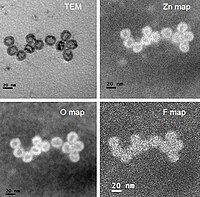
Photo from wikipedia
Polyoxometalate based solids are promising candidates of proton-conducting solid electrolytes. In this work, a Preyssler-type polyoxometalate is crystallized with potassium ions and poly(allylamine), which is also a good proton conductor,… Click to show full abstract
Polyoxometalate based solids are promising candidates of proton-conducting solid electrolytes. In this work, a Preyssler-type polyoxometalate is crystallized with potassium ions and poly(allylamine), which is also a good proton conductor, from aqueous solutions. Here we show that the hygroscopicity induced low durability of polyoxometalate and poly(allylamine) can be circumvented by the electrostatic interaction between the polyoxometalate and protonated amine moieties in the solid state. Crystalline compounds are synthesized with poly(allylamine) of different average molecular weights, and all compounds achieve proton conductivities of 10−2 S cm−1 under mild-humidity and low-temperature conditions. Spectroscopic studies reveal that the side-chain mobility of poly(allylamine) and hydrogen-bonding network rearrangement contribute to the proton conduction of compounds with poly(allylamine) of low and high average molecular weights, respectively. While numbers of proton-conducting amorphous polyoxometalate-polymer composites are reported previously, these results show both structure-property relationship and high functionality in crystalline composites.Polyoxometalate based solids are promising candidates for proton-conducting electrolytes but their low durability and low proton conductivities remains an on-going challenge. Here the authors describe the preparation of polyoxometalate-based solids with much improved stability and proton conductivities.
Journal Title: Communications Chemistry
Year Published: 2019
Link to full text (if available)
Share on Social Media: Sign Up to like & get
recommendations!